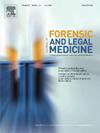妇产科医疗诉讼结果的风险因素分析:对日本 344 起索赔案的回顾性队列研究
IF 1.2
4区 医学
Q3 MEDICINE, LEGAL
引用次数: 0
摘要
目的医疗差错是妇产科(OB/GYN)的关键问题,也是导致高诉讼风险的原因之一。然而,很少有研究将系统错误和诊断错误视为潜在的可预防问题。本研究旨在通过识别和解决关键的促成因素来加强医疗安全和减少诉讼。方法我们回顾性地检索了日本全国医疗事故索赔数据库中1961年至2017年间的妇产科病例。我们评估了提供者的特征和患者(原告)的背景信息。主要结果是最终判决中的诉讼(接受或拒绝)。我们使用多变量逻辑回归模型评估了医疗事故变量(系统和诊断错误、机构规模、情况、地点、时间和临床结果)与诉讼结果(接受)之间的关联。其中,产科 277 例(80.5%),妇科 67 例(19.5%)。在产科病例中,193 例为围产期病例,84 例为孕产期病例。有 185 例(53.8%)接受了渎职索赔(妇产科损失)。在多变量分析中,系统错误(几率比 97.4,95% 置信区间 35.2-270.0)、诊断错误(几率比 4.5,95% 置信区间 1.8-11.3)和诊所(几率比 2.7,95% 置信区间 1.2-4.8)与受理索赔有显著的统计学关联。这些发现突出表明,有必要在医生层面和医疗保健管理系统内解决可改变的因素,以加强患者安全和降低诉讼风险,从而确保为患者和医疗专业人员提供更安全、更可靠的医疗保健环境。本文章由计算机程序翻译,如有差异,请以英文原文为准。
Risk factor analysis of medical litigation outcomes in obstetrics and gynecology: A retrospective cohort study of 344 claims in Japan
Aim
Medical errors are critical in obstetrics and gynecology (OB/GYN) and contribute to high litigation risks. However, few studies have examined system and diagnostic errors as potential preventable problems. This study aimed to enhance medical safety and reduce litigation by identifying and addressing key contributory factors.
Methods
We retrospectively searched the national Japanese malpractice claims database for OB/GYN cases between 1961 and 2017. We evaluated provider characteristics and background information of the patients (plaintiffs). The main outcome was litigation (acceptance or rejection) in the final judgment. Using multivariable logistic regression models, we assessed the associations between medical malpractice variables (system and diagnostic errors, facility size, situation, place, time, and clinical outcomes) and litigation outcomes (acceptance).
Results
Overall, 344 malpractice claims were analyzed. Among these, 277 (80.5 %) were obstetric, and 67 (19.5 %) were gynecological. Of the obstetric cases, 193 were perinatal, and 84 were maternal. Malpractice claims were accepted (OB-GYN losses) in 185 cases (53.8 %). In multivariable analyses, system errors (odds ratio 97.4, 95 % confidence interval 35.2–270.0), diagnostic errors (odds ratio 4.5, 95 % confidence interval 1.8–11.3), and clinic (odds ratio 2.7, 95 % confidence interval 1.2–4.8) had a significant statistical association with accepted claims.
Conclusion
System errors, diagnostic errors, and clinics were significantly associated with acceptance claims. These findings underscore the necessity of addressing modifiable factors at the physician level and within the healthcare management system to enhance patient safety and reduce litigation risks, thereby ensuring a safer and more reliable healthcare environment for patients and medical professionals.
求助全文
通过发布文献求助,成功后即可免费获取论文全文。
去求助
来源期刊

Journal of forensic and legal medicine
MEDICINE, LEGAL-
CiteScore
2.70
自引率
6.70%
发文量
106
审稿时长
57 days
期刊介绍:
The Journal of Forensic and Legal Medicine publishes topical articles on aspects of forensic and legal medicine. Specifically the Journal supports research that explores the medical principles of care and forensic assessment of individuals, whether adult or child, in contact with the judicial system. It is a fully peer-review hybrid journal with a broad international perspective.
The Journal accepts submissions of original research, review articles, and pertinent case studies, editorials, and commentaries in relevant areas of Forensic and Legal Medicine, Context of Practice, and Education and Training.
The Journal adheres to strict publication ethical guidelines, and actively supports a culture of inclusive and representative publication.
 求助内容:
求助内容: 应助结果提醒方式:
应助结果提醒方式:


